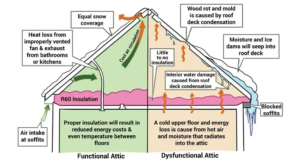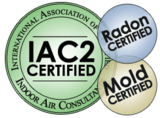 When it comes to enhancing both energy efficiency and comfort in your home, attic insulation plays a pivotal role. Proper attic insulation doesn’t just help keep your home cozy throughout the year—it can also drastically reduce your energy bills and prolong the life of your HVAC system. In this blog post, we’ll guide you through the essentials of attic insulation and why it’s such an important investment for any homeowner.
When it comes to enhancing both energy efficiency and comfort in your home, attic insulation plays a pivotal role. Proper attic insulation doesn’t just help keep your home cozy throughout the year—it can also drastically reduce your energy bills and prolong the life of your HVAC system. In this blog post, we’ll guide you through the essentials of attic insulation and why it’s such an important investment for any homeowner.
The Role of Attic Insulation
Attic insulation acts as a protective barrier that keeps your home’s temperature regulated. During the winter, it helps trap heat inside your home, while in the summer, it prevents outdoor heat from seeping in. This thermal resistance maintains a stable indoor temperature, which ultimately reduces the workload on your heating and cooling systems. The result? You can save up to 20% on your energy bills, all while making your home more comfortable.
Types of Attic Insulation
Choosing the right insulation material is crucial for maximizing both efficiency and comfort. Here are the most common types of attic insulation, each with its pros and cons:
Fiberglass Batt Insulation
Fiberglass batt insulation is one of the most popular and affordable choices for attic spaces. This material comes in large rolls or pre-cut batts, which are placed between attic joists. While fiberglass batt insulation is easy to install, it requires precise placement to ensure no gaps, as these can drastically reduce its effectiveness.
Blown-In Insulation
Blown-in insulation—typically made from fiberglass, cellulose, or mineral wool—is a great choice for attics with lots of nooks and crannies. A professional installer uses a machine to blow loose insulation into the space, filling gaps and covering irregular areas more effectively than batt insulation. This type is ideal for older homes or attics that need additional insulation.
Spray Foam Insulation
Spray foam insulation offers some of the highest thermal resistance and can also serve as an air barrier, preventing the infiltration of outside air. Applied as a spray, it expands to fill cracks and gaps, creating a seamless layer of insulation. Though more expensive, spray foam offers superior energy savings and is often worth the investment for long-term benefits.
Evaluating Your Attic’s Insulation Needs
Before adding or replacing insulation in your attic, you’ll need to assess the current levels. This is typically done by measuring the thickness of the existing insulation and comparing it to the recommended levels for your climate zone. The U.S. Department of Energy offers guidelines for the appropriate R-values (thermal resistance) for various regions, helping you determine whether your attic is adequately insulated.
Signs Your Attic Needs More Insulation
Several red flags indicate it might be time to upgrade your attic insulation:
-
Uneven Temperatures: If certain areas of your home are consistently colder or warmer than others, your attic insulation may be lacking.
-
High Energy Bills: Higher-than-normal energy costs, especially during extreme weather months, can suggest that your attic isn’t performing as it should.
-
Drafty Rooms: Noticeable drafts, particularly in rooms located under the attic, can indicate poor insulation.
-
Visible Joists: If you can see the floor joists in your attic, it’s a clear sign that there’s not enough insulation to fully cover the space.
Installing Attic Insulation
While some homeowners may feel confident about installing insulation on their own, it’s often best to leave the job to a professional. Proper insulation installation is critical to ensure it performs at its best. Professionals can accurately assess your attic’s specific needs, recommend the best insulation material, and ensure the insulation is installed correctly, maximizing its effectiveness.
Benefits of Proper Attic Insulation
Investing in high-quality attic insulation offers numerous long-term advantages, such as:
-
Lower Energy Bills: The most immediate benefit is lower utility costs, as your heating and cooling systems won’t need to work as hard to maintain your home’s temperature.
-
Increased Comfort: A well-insulated attic ensures your home remains comfortable year-round, with fewer temperature fluctuations and reduced drafts.
-
Improved Air Quality: Proper insulation helps reduce air leaks, keeping outdoor pollutants and allergens from entering your home.
-
Protection Against Moisture Damage: Insulation also helps prevent moisture buildup in the attic, which can lead to mold growth and structural damage.
Maintaining Your Insulation
Once your attic is properly insulated, maintenance is key to keeping it in optimal condition. Regularly inspect your attic for signs of damage, such as moisture or pest infestations, which can degrade the insulation’s performance. If you notice any issues, address them promptly to ensure your insulation continues to keep your home comfortable and energy-efficient.
Conclusion
Attic insulation is one of the most effective ways to enhance your home’s energy efficiency, comfort, and long-term durability. By understanding the different types of insulation, assessing your attic’s specific needs, and ensuring proper installation and maintenance, you can enjoy all the benefits of a well-insulated home. If you’re unsure about your attic’s insulation or if it’s time for an upgrade, consulting a professional can help you make the best decisions for your home and budget. Don’t wait—insulating your attic is an investment that will pay off in comfort and savings for years to come.

